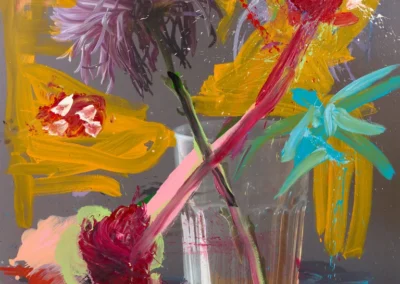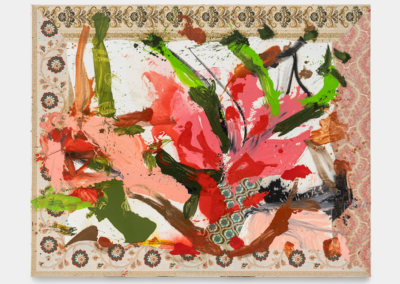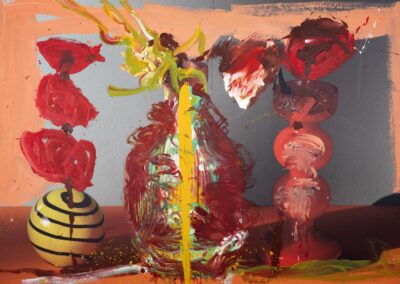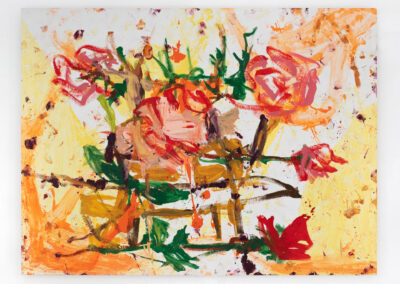Our next Artist You Need To Know is Jorge Galindo.
Galindo was born in 1958 in Madrid, Spain, and studied in the workshops of the Círculo de Bellas Artes in Madrid. He’s been making work for more than three decades : his artworks are immediately recognizable for their expressionistic and gestural style, while also employing collage and other mixed media elements.
He has been acclaimed as one of the most important contemporary Spanish artists of his generation (and much of his work draws upon the history of art in Spain, as some critics position him as an “heir to the Spanish pictorial tradition”, while also keeping an eye to contemporary cultural touchstones). Galindo is perhaps best known for his large scale floral works that blur and challenge the ‘line’ between still-life and abstraction.
Galindo has described his artwork as ‘Dirty Pop’ : “Using a range of materials, his lush and colorful surfaces are executed in an energetic, sometimes chaotic style.” (from Almine Rech)
From Brooklyn Rail : “Galindo’s practice has always explored cutouts from old magazines, wallpaper, postcards, posters, album covers, and often, everyday materials found in life or at flea markets…..his wildly energized brushwork gives renewed life to the materials he collects for collage, his new work revisiting recurrent themes. It seems we enter his metaphorical garden full of anticipation for the next series of works, perhaps filled with more surprises that unite and question how we determine what is old, used, or salvaged, or new, spontaneous, or chaotic.”
“Galindo is one of those artists who – in the wake of a very rich tradition that, in fact, began with Goya – learned to bring from the streets an energy that almost impetuously leads directly to painting, made up of impulses, visual elements, ideas, forces, and intensities that are able to brutally confront us with an unforeseen scale of accidents. In his work, indeed, the sense of experimentation and risk is so intense and willing to take on challenges that, with each gesture, the paintings approach the possibility of their own failure, of their accidents and even their own impossibility.” (from Ocula)
Galindo’s artwork draws on a variety of inspiration, both historical and contemporary, as well as high culture and ‘lower’ pop culture. From the Vito Schnabel Gallery : “His visceral marks in paint animate the traditional still life motif, pushing the realism of a 17th century Dutch flower painting into the realm of abstraction. The subject matter first appeared in Galindo’s work in 2009, inspired by a floral still life by Henri Fantin-Latour that was reproduced as the cover art of the English rock band New Order’s 1983 album Power, Corruption & Lies. Galindo returned to the subject of flowers in 2019, in a collaboration with the Spanish film director Pedro Almodóvar [a number of those images are in the gallery above this text]. Combining elements of painting, photography, and collage, he enlarged a series of Almodóvar’s still life photographs as the ground for new paintings, which the duo realized together— applying paint with brushes as well as with their hands and feet.”
The sheer size of his paintings both dominate the viewer but also speak to an almost performative aspect of Galindo’s painting and the intense nature of the activity. Galindo has spoken of how a formative moment in his career as an artist was in 1988, when he was at the Talleres de Arte Actual (organised by Círculo de Bellas Artes de Madrid) and he knew that his “painting would not be merely an expressive receptacle but a vital attitude.” In this respect, his collaboration with Almodóvar is not another instance of celebrities in other fields touristing in painting but recognizing a collusion of aesthetics : many Spanish cultural critics have spoken of how, in the period of Spain after the dictatorship of Franco, that many artists employ colour and form in an intense and liberated style that speaks to – and reflects – the freedoms after that period of autocratic rule.
Galindo’s work has been exhibited internationally including at the Hamburger Bahnhof (Berlin); Hirshhorn Museum (Washington D.C.); Museo Nacional Centro de Arte Reina Sofía (Madrid); the Hammer Museum of Art (Los Angeles, CA); The Hall Foundation of Art (Reading, VA, USA); and Kunstmuseum Schloss Derneburg (Germany).
His artwork can be found in numerous collections, including Museo Nacional Centro de Arte Reina Sofía (Madrid, Spain), Museo de Arte Contemporáneo de Castilla y León, (Spain), Museo Helga de Alvear (Cáceres, Spain), Hall Art Foundation, Scholss Derneburg (Germany), Museo Patio Herreriano, Valladolid (Spain), Museo Municipal de Arte Contemporáneo (Madrid, Spain), Museo Marugame Hirai (Japan), ING Belgium Collection (Brussels, Belgium), and many others. A more detailed listing can be seen here.
Galindo divides his time between Porto, Portugal and Toledo, Spain. More about his life and work can be seen here.
























